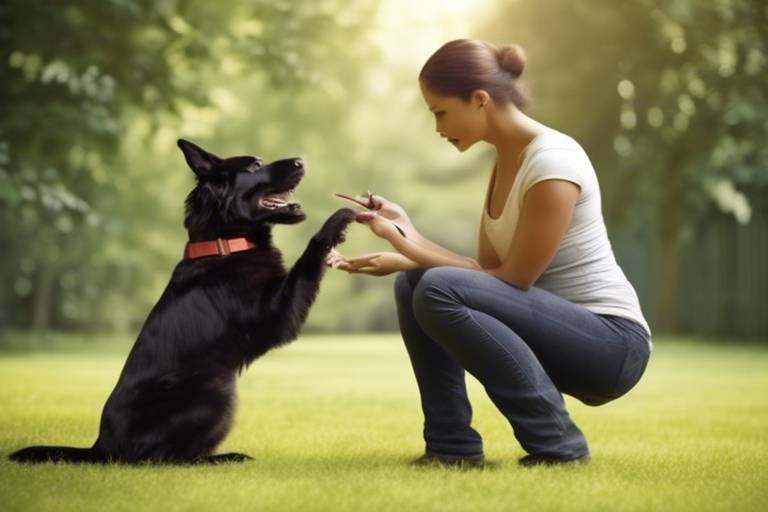Understanding the Role of Emotions in Pet Behavior
Have you ever looked into your pet's eyes and felt like they were trying to tell you something? You're not alone! Our furry friends are more than just companions; they are emotional beings that experience a wide range of feelings, just like us. Understanding the role of emotions in pet behavior is crucial for creating a harmonious living environment. It can transform a simple relationship into a deep, meaningful bond that enriches both your life and your pet's.
When we talk about emotions in pets, we're diving into a fascinating world where biology meets psychology. Did you know that recent research suggests pets can experience emotions such as joy, fear, and even jealousy? This revelation opens up a new perspective on how we interact with our pets. It's not just about feeding them or taking them for walks; it's about understanding their emotional needs and responding to them appropriately.
Imagine your dog wagging its tail vigorously when you come home. That joyful greeting isn't just a reflex; it’s a clear expression of happiness and excitement. Similarly, when a cat purrs while being petted, it signals contentment and trust. These emotional cues are vital in understanding how our pets feel and what they need from us. By tuning into these signals, we can enhance their quality of life and foster a stronger bond.
Moreover, recognizing that pets have their own emotional landscapes helps us become more empathetic pet owners. Just like humans, pets can experience a rollercoaster of emotions influenced by their environment, interactions, and even past experiences. For instance, a rescue dog may take longer to trust its new owner due to previous trauma, while a well-socialized puppy may be more outgoing and playful. Understanding these differences is key to providing the best care possible.
As we explore the intricate relationship between emotions and pet behavior, we will uncover practical strategies that can help enhance this bond. From recognizing emotional triggers to employing techniques that promote emotional well-being, this journey promises to be enlightening. So, let’s delve deeper into the science of animal emotions and discover how they shape the behavior of our beloved pets.
In recent years, the scientific community has made significant strides in understanding animal emotions. Research indicates that many pets, particularly dogs and cats, possess emotional capacities that mirror those of humans. For example, studies show that dogs have a similar brain structure to humans when it comes to processing emotions. This means they can feel happiness, sadness, and even stress. Isn't it fascinating to think that your dog might be experiencing the same feelings you are?
Furthermore, the emotional responses of animals can be traced back to their evolutionary history. For instance, social animals like dogs and cats have developed emotional responses that help them bond with humans and other animals. This bonding is essential for their survival and well-being. Understanding these biological and psychological foundations can help pet owners create a nurturing environment that caters to their pets’ emotional needs.
Understanding what triggers specific emotions in pets is fundamental for any pet owner. Just like humans, pets can react differently to various stimuli in their environment. For example, loud noises, unfamiliar people, or sudden changes in routine can evoke fear or anxiety in pets. Recognizing these triggers allows owners to respond appropriately and create a safe space for their pets.
Fear and anxiety are prevalent emotions in pets, often manifesting in various behaviors such as barking, hiding, or destructive actions. These reactions can stem from a range of causes, including past trauma, lack of socialization, or even health issues. It's essential for pet owners to recognize the signs of fear and anxiety in their pets to address these feelings effectively.
Stress can significantly impact pet behavior, leading to health issues and behavioral problems. Pets under stress may exhibit changes in appetite, aggression, or withdrawal. Recognizing the signs of stress can help owners take proactive steps to mitigate its effects. For instance, creating a calm environment, providing safe spaces, and ensuring regular exercise can help alleviate stress in pets.
To help reduce anxiety in pets, consider implementing the following strategies:
- Provide a safe and quiet space for your pet to retreat to when feeling overwhelmed.
- Use positive reinforcement training techniques to build confidence.
- Engage in regular playtime to stimulate their mind and body.
- Consider calming products, such as anxiety wraps or pheromone diffusers.
On the flip side, happiness is essential for a pet's well-being. A happy pet is more likely to be well-adjusted and exhibit positive behaviors. Signs of a happy pet include wagging tails, playful antics, and a relaxed body posture. Engaging in play is crucial for fostering these positive emotions. Whether it's a game of fetch with your dog or a feather toy for your cat, playtime is a fantastic way to strengthen your bond and keep your pet emotionally healthy.
Building a strong bond with pets requires emotional insight. The more we understand our pets' emotional needs, the better we can respond to them. Empathy plays a vital role in enhancing the human-animal relationship. By recognizing and validating their feelings, we can create a loving and supportive environment for our pets.
Pets communicate their emotions through body language and vocalizations. Learning to interpret these cues can significantly improve your responsiveness to a pet's emotional state. For example, a wagging tail in dogs often indicates happiness, while a lowered head and tucked tail may signal fear. By paying attention to these signals, you can better meet your pet's emotional needs.
Training can significantly influence a pet's emotional well-being. Positive reinforcement techniques foster trust and emotional stability in pets. When pets feel secure and understood, their emotional health improves, leading to better behavior and a stronger bond with their owners. Remember, a well-trained pet is not just obedient; it's also happier and more confident!
Q: Can pets really feel emotions like humans?
A: Yes! Research shows that pets, especially dogs and cats, experience a range of emotions similar to humans, including joy, fear, and anxiety.
Q: How can I tell if my pet is stressed?
A: Signs of stress in pets can include changes in appetite, excessive barking, hiding, or destructive behavior. Observing these changes can help you address their emotional needs.
Q: What are some ways to reduce my pet's anxiety?
A: Providing a safe space, engaging in regular play, and using positive reinforcement training are effective strategies to help reduce anxiety in pets.
Q: How important is playtime for my pet's happiness?
A: Playtime is crucial for a pet's emotional health. It stimulates their mind and body, fosters happiness, and strengthens the bond between you and your pet.

The Science of Animal Emotions
When we think about emotions, we often picture humans laughing, crying, or expressing joy and sadness. However, the reality is that our furry friends—dogs, cats, and even more exotic pets—experience a wide range of emotions too. Recent research has highlighted that the emotional lives of animals are far more complex than we previously understood. Just like us, pets can feel joy, fear, anger, and even love. This understanding is crucial for pet owners who wish to foster a supportive and nurturing environment for their beloved companions.
Studies in animal behavior and psychology have shown that many animals possess similar brain structures to humans, particularly in areas that govern emotional responses. For instance, the amygdala, a part of the brain responsible for processing emotions, is present in both humans and animals. This suggests that pets not only experience emotions but also react to them in ways that mirror human responses. A dog's wagging tail when they see their owner is not just a reflex; it's an expression of happiness and excitement.
Moreover, researchers have utilized various methods, including neuroimaging and behavioral studies, to assess how animals express and experience emotions. For example, a study involving dogs demonstrated that they can differentiate between human emotions based on facial expressions. When presented with images of happy and angry faces, dogs showed distinct behavioral changes, indicating their ability to sense and respond to the emotional states of humans.
To further illustrate the emotional complexity of animals, let’s consider a few key points:
- Empathy in Animals: Some species, like elephants and dolphins, have shown signs of empathy, often comforting distressed companions.
- Playfulness: Play is a vital emotional outlet for many animals, allowing them to express joy and build social bonds.
- Stress Responses: Just like humans, pets can experience stress, which can lead to behavioral issues if not addressed appropriately.
Understanding the science of animal emotions not only enriches our knowledge but also enhances our ability to connect with our pets on a deeper level. By recognizing that our pets have emotional lives, we can make more informed decisions about their care, training, and overall well-being. This emotional insight fosters a stronger bond, making our relationships with our pets more fulfilling and rewarding.
- Do pets really experience emotions like humans? Yes, research indicates that pets can experience a range of emotions similar to humans, including happiness, fear, and anxiety.
- How can I tell if my pet is happy? Signs of a happy pet include a wagging tail, playful behavior, and a relaxed body posture.
- What can I do to help my pet manage stress? Providing a safe environment, consistent routines, and engaging in positive reinforcement training can help alleviate stress in pets.

Understanding the emotional triggers in our beloved pets is crucial for any responsible pet owner. Just like us, pets experience a wide range of emotions, and these feelings can be influenced by various stimuli in their environment. When we recognize what evokes specific emotions in our pets, we can respond more appropriately and effectively to their needs. For instance, a loud noise might send a dog into a panic, while a gentle touch can bring comfort. By being attuned to these emotional triggers, we can create a more harmonious living space for our furry friends.
Different species of pets react to various stimuli in unique ways. For example, dogs are often triggered by sounds, smells, and visual cues, while cats may be more sensitive to changes in their environment or the presence of unfamiliar people. Understanding these differences can help us tailor our approach to each pet's emotional landscape. Here are some common emotional triggers that can affect pets:
- Environmental Changes: Moving to a new home or rearranging furniture can unsettle pets, leading to anxiety and stress.
- Social Interactions: Pets may react differently to the presence of strangers, other animals, or even changes in their owner's mood.
- Sound Sensitivity: Loud noises, like thunderstorms or fireworks, can trigger fear responses, especially in dogs.
- Routine Disruptions: Pets thrive on routine, and any changes—such as an altered feeding schedule—can lead to confusion and anxiety.
Recognizing these triggers allows us to be proactive in managing our pets' emotional health. For instance, if you know that your dog is afraid of thunderstorms, you can create a safe space for them with their favorite toys and blankets. Similarly, if your cat seems stressed by visitors, providing them with a quiet retreat can help ease their anxiety. By anticipating and addressing these triggers, we not only promote emotional well-being but also strengthen the bond we share with our pets.
Moreover, it's essential to observe your pet's body language and vocalizations, as these can provide valuable insights into their emotional state. A wagging tail might indicate happiness, while flattened ears could signal fear or discomfort. By being mindful of these cues, we can learn to respond more effectively to our pets' needs and emotions, ultimately enhancing their quality of life.
In conclusion, understanding emotional triggers in pets is about more than just recognizing their behavior; it's about fostering a deeper connection with them. By being aware of what affects their emotions, we can create a supportive environment that promotes happiness and reduces anxiety. This emotional awareness is key to nurturing a loving and trusting relationship with our furry companions.
Q1: How can I tell if my pet is experiencing anxiety?
A1: Common signs of anxiety in pets include excessive barking, hiding, pacing, or destructive behavior. If you notice these signs, it may be time to assess their environment and routines.
Q2: What should I do if my pet is scared of loud noises?
A2: Create a safe space for your pet during loud events. Use calming products such as anxiety wraps or pheromone diffusers, and consider desensitization training to help them cope.
Q3: Can pets feel happiness?
A3: Absolutely! Pets express happiness through playful behavior, wagging tails, and relaxed body language. Regular playtime and affection can enhance their overall happiness.
Q4: How can I improve my pet's emotional well-being?
A4: Regular exercise, mental stimulation, and positive reinforcement training can significantly improve your pet's emotional health. Additionally, spending quality time together strengthens your bond.
Fear and anxiety are two of the most common emotional responses observed in pets, and understanding these feelings is crucial for responsible pet ownership. Just like us, our furry friends can experience a range of emotions, and when those emotions turn to fear or anxiety, it can lead to a host of behavioral problems. Imagine your pet as a tiny version of yourself, navigating a world filled with strange noises, unfamiliar faces, and sudden changes. When confronted with these challenges, their instinctual responses can manifest in various ways, from hiding under the bed to excessive barking or even destructive behavior.
One of the primary causes of fear in pets can be attributed to their past experiences. For instance, a dog that was previously abused may react with panic at the sight of a raised hand, while a cat that was once frightened by a loud noise may become skittish at the sound of thunder. It's essential to recognize that each pet has its own unique history, which shapes its emotional responses. Moreover, certain breeds are more predisposed to anxiety than others, and understanding these predispositions can help owners prepare for potential issues.
So, how can you tell if your pet is feeling anxious or afraid? Here are some common signs to watch for:
- Excessive barking or meowing
- Hiding or seeking out secluded areas
- Avoidance of certain people or situations
- Destructive behaviors, like chewing or scratching
- Changes in appetite or sleeping patterns
Recognizing these signs early is key to addressing your pet's fears. Ignoring these behaviors can lead to more severe anxiety issues, which may require professional intervention. As a pet owner, it’s your responsibility to create a safe and secure environment where your pet feels comfortable and can thrive. One effective strategy is to identify specific triggers that cause fear or anxiety in your pet. This might include loud noises, unfamiliar animals, or even certain people. Once identified, you can work on desensitizing your pet to these triggers through gradual exposure and positive reinforcement.
Moreover, stress can exacerbate these emotional challenges. Just like humans, pets can feel overwhelmed, and this stress can lead to further behavioral issues. It's important to be aware of your pet's stress levels and to implement strategies that can help reduce this stress. For example, creating a quiet space for your pet to retreat to when they feel overwhelmed can be incredibly beneficial. This safe haven can be a cozy bed in a quiet room, away from the hustle and bustle of daily life.
In conclusion, understanding fear and anxiety in pets is not just about recognizing the signs but also about taking proactive steps to mitigate these emotions. By fostering a nurturing environment and being attentive to your pet's needs, you can help them navigate their fears and thrive emotionally. Remember, a happy pet is a well-adjusted pet, and your efforts to understand their emotional landscape will lead to a stronger bond between you and your furry companion.
Q: How can I tell if my pet is anxious?
A: Look for signs such as excessive barking, hiding, changes in appetite, or destructive behavior. If you notice these signs, it may indicate that your pet is feeling anxious.
Q: What can I do to help my anxious pet?
A: Create a safe space for your pet, identify and address triggers, and consider using positive reinforcement training to help them feel more secure.
Q: Should I consult a veterinarian about my pet's anxiety?
A: Yes, if your pet's anxiety seems severe or unmanageable, it’s a good idea to consult a veterinarian. They can provide guidance and, if necessary, recommend treatments.
Stress in pets is more than just a passing phase; it can lead to serious consequences that affect their overall well-being and behavior. Just like humans, pets experience stress, and it can manifest in various ways. When a pet is stressed, you might notice changes in their behavior, such as increased aggression, withdrawal, or destructive actions. Understanding these behaviors is crucial for any pet owner who wants to ensure a happy and healthy environment for their furry friends.
For instance, a dog that suddenly becomes aggressive might be reacting to a stressful situation, whether it’s a loud noise, a new person in the house, or even a change in routine. Similarly, a cat that hides under the bed for days could be feeling overwhelmed by environmental changes or even by the presence of other pets. Recognizing these signs early on can help you address the root cause of the stress before it escalates into more severe behavioral issues.
Stress can also lead to physical health problems in pets. You may notice your pet exhibiting signs such as excessive grooming, which can result in skin irritations, or gastrointestinal issues like diarrhea or vomiting. These physical manifestations of stress highlight the deep connection between emotional and physical health in animals. To better understand this relationship, consider the following table that outlines common stress-related behaviors and their potential physical effects:
| Behavior | Potential Physical Effects |
|---|---|
| Excessive barking or meowing | Throat irritation or damage |
| Aggression towards people or other pets | Increased heart rate and stress hormones |
| Destructive behavior (chewing, scratching) | Injuries or dental problems |
| Withdrawal or hiding | Weight loss and lethargy |
To combat stress, it’s essential to create a stable and predictable environment for your pets. This includes maintaining a consistent daily routine for feeding, walking, and playtime. Additionally, providing a safe space where your pet can retreat when feeling overwhelmed is key. This could be a cozy corner with their favorite blanket or a designated room where they can feel secure. Remember, just like us, pets thrive on routine and familiarity.
In conclusion, understanding the effects of stress on your pet’s behavior is vital for their emotional and physical health. By recognizing the signs of stress and taking proactive measures to alleviate it, you can help your furry companions lead happier, healthier lives.
Q: How can I tell if my pet is stressed?
A: Look for signs such as excessive barking, hiding, aggression, or changes in eating habits. If your pet is displaying any of these behaviors, it may be a sign of stress.
Q: What are the best ways to reduce my pet's stress?
A: Establish a consistent routine, provide a safe space, engage in regular exercise, and consider using calming products like pheromone diffusers or anxiety wraps.
Q: Can stress affect my pet's health?
A: Yes, stress can lead to various health issues, including gastrointestinal problems, skin irritations, and weakened immune function.
Q: Is it normal for pets to experience stress?
A: Absolutely! Just like humans, pets can experience stress due to changes in their environment, routine, or social interactions.
Reducing anxiety in pets is not just about alleviating their distress; it's about enhancing their overall quality of life. Just like humans, our furry friends can experience a range of emotions, and anxiety can manifest in various ways, from excessive barking to destructive behaviors. The good news is that there are several effective strategies you can implement to help your pet feel more secure and relaxed in their environment.
First and foremost, creating a calm environment is crucial. Pets are incredibly sensitive to their surroundings, and a noisy or chaotic home can significantly heighten their anxiety levels. Consider designating a quiet space in your home where your pet can retreat when feeling overwhelmed. This area should be comfortable and familiar, perhaps filled with their favorite toys or blankets. Additionally, using calming aids such as white noise machines or calming music can help drown out sudden noises that might trigger anxiety.
Another effective approach is to incorporate more exercise and play into your pet's daily routine. Just like us, pets benefit from physical activity that helps release pent-up energy and reduces stress. Regular walks, interactive play sessions, or even agility training can do wonders for their mental health. Not only does this provide a distraction, but it also fosters a stronger bond between you and your pet through shared activities. Remember, a tired pet is often a happy pet!
Training plays a vital role in reducing anxiety as well. Using positive reinforcement techniques can help your pet build confidence and trust in you as their owner. For example, teaching basic commands like "sit" or "stay" can create a sense of structure and predictability in their lives, which can be very comforting. When your pet successfully follows a command, reward them with treats or praise to reinforce their behavior positively. This not only promotes good behavior but also strengthens your relationship.
In some cases, you may need to explore behavioral interventions. These can include desensitization techniques, where you gradually expose your pet to the source of their anxiety in a controlled manner. For example, if your dog is anxious around strangers, invite a friend over and have them interact with your pet while rewarding calm behavior. This method helps your pet associate positive experiences with previously frightening stimuli.
Lastly, don’t underestimate the power of professional help. If your pet's anxiety is severe or persistent, consulting with a veterinarian or a certified animal behaviorist can provide you with tailored strategies and, if necessary, medical options. They can assess your pet's specific needs and suggest treatments that can significantly improve their emotional well-being.
In summary, reducing anxiety in pets requires a multifaceted approach that combines environmental adjustments, physical activity, training, and potentially professional guidance. By being attentive to your pet's emotional needs, you can create a safe and nurturing environment that fosters happiness and reduces anxiety, ultimately leading to a more fulfilling life for both you and your furry companion.
- What are the signs of anxiety in pets? Common signs include excessive barking, destructive behavior, hiding, and changes in appetite.
- Can anxiety in pets be treated with medication? Yes, in some cases, medication prescribed by a veterinarian can help manage anxiety.
- How long does it take to see improvements in anxious pets? Improvements can vary, but consistent efforts usually yield noticeable changes within a few weeks.
- Are certain breeds more prone to anxiety? Yes, some breeds, such as Border Collies and Chihuahuas, may be more prone to anxiety than others.
When it comes to our furry friends, happiness is more than just a wagging tail or a playful pounce; it’s a vital part of their overall well-being. Just like humans, pets experience a spectrum of emotions, and their happiness can often be measured by their behavior. A content pet will exhibit certain signs that reflect their emotional state. For instance, a dog that rolls over for belly rubs, a cat that kneads your lap, or a rabbit that binkies around the room are all indicators of joy. Understanding these behaviors can help pet owners create an environment where their pets thrive.
Playfulness is an essential component of a happy pet’s life. It’s not just about having fun; playtime is crucial for physical exercise, mental stimulation, and strengthening the bond between pets and their owners. Engaging in play allows pets to express their natural instincts and social behaviors. For example, dogs enjoy games of fetch, while cats might prefer chasing after a feather toy or a laser pointer. These activities not only keep them fit but also provide an outlet for their energy, reducing the likelihood of destructive behavior.
Moreover, the type of play can vary significantly between species. Here are some common signs of happiness during playtime:
- Dogs: Tail wagging, playful barking, and a relaxed body posture.
- Cats: Pouncing, chasing, and playful swatting at toys.
- Rabbits: Binkying, zooming around, and digging at the ground.
Creating a playful environment can greatly enhance your pet's happiness. This can involve setting aside time each day for interactive play, providing a variety of toys, or even scheduling playdates with other pets. Remember, the goal is to stimulate both their body and mind. Just like us, pets can get bored, and boredom can lead to anxiety or behavioral issues. By introducing new games or rotating toys, you can keep their interest piqued and their spirits high.
In addition to structured play, it’s essential to recognize that happiness in pets also stems from their everyday interactions with their human companions. Simple acts like cuddling, petting, or even talking to them can boost their mood significantly. Pets are incredibly perceptive and can sense their owner's emotions, so maintaining a positive atmosphere at home can lead to a happier pet.
In conclusion, fostering happiness and playfulness in pets is a rewarding endeavor that requires attention, time, and a bit of creativity. By being attuned to their emotional needs and providing ample opportunities for play, you can ensure that your beloved companion leads a joyful and fulfilling life.
1. How can I tell if my pet is happy?
Look for signs such as relaxed body language, playful behavior, and a willingness to engage with you or their environment. Happy pets often exhibit behaviors like wagging their tails, purring, or bouncing around.
2. What types of toys are best for keeping my pet happy?
Choose toys that cater to your pet's natural instincts. For dogs, consider chew toys and fetch toys; for cats, opt for feather wands and laser pointers. For small animals like rabbits, tunnels and chewable toys are great options.
3. How much playtime does my pet need?
This varies by species and individual needs. Generally, dogs require at least 30 minutes to 2 hours of playtime daily, while cats benefit from several short play sessions throughout the day. Always observe your pet’s behavior to gauge their play needs.

Building a strong bond with our pets is not just about feeding them or taking them for walks; it’s about truly understanding their emotions. Just like us, pets experience a wide range of feelings, and recognizing these emotions is crucial for nurturing a healthy relationship. When we take the time to understand what our furry friends are feeling, we can respond in ways that enhance their happiness and well-being. But how do we achieve this emotional insight? Let’s dive into the importance of empathy and understanding in strengthening the human-animal relationship.
First and foremost, empathy is key. It’s about putting ourselves in our pets' paws—imagining how they feel in different situations. For instance, when your dog cowers during a thunderstorm, it’s not just being dramatic; it’s genuinely frightened. By acknowledging their fear, we can provide comfort and reassurance. This emotional connection fosters trust, making our pets feel safe and secure in our presence. Remember, a pet that feels understood is a pet that will reciprocate with love and loyalty.
Moreover, understanding our pets’ emotions can significantly improve their behavior. When we recognize the signs of anxiety or stress, we can take proactive steps to alleviate those feelings. For example, if your cat is hiding or your dog is barking excessively, these could be signals of emotional distress. By identifying these cues, we can create a more harmonious living environment. This is where emotional awareness comes into play—by being attuned to our pets' needs, we can modify our interactions, leading to a more fulfilling companionship.
To facilitate this emotional bond, it’s essential to learn the communication cues our pets use. Pets communicate their feelings through body language, vocalizations, and even facial expressions. For instance, a wagging tail can indicate excitement, while flattened ears might suggest fear. By observing these signals, we can respond appropriately. Here are a few common cues to watch for:
- Tail Position: A high, wagging tail often means happiness, while a low tail can indicate submission or fear.
- Ear Position: Forward-facing ears show curiosity, whereas ears pinned back can signal anxiety.
- Vocalizations: Different sounds can denote various emotions—playful barks versus distressed whines.
Additionally, the role of training cannot be overstated when it comes to emotional health. Training is not just about teaching commands; it’s about building a relationship based on trust and respect. Positive reinforcement techniques, such as rewarding good behavior with treats or praise, can significantly enhance a pet's emotional stability. When pets learn that they can trust us to provide guidance and support, they become more confident and less anxious. It’s a win-win situation!
In conclusion, bonding with our pets through emotional understanding is a journey that requires patience, empathy, and observation. By recognizing and responding to their emotions, we not only improve their lives but also enrich our own. The joy that comes from a deep, trusting relationship with our pets is immeasurable. So, the next time you interact with your furry friend, take a moment to consider their feelings—your bond will grow stronger, and your connection will thrive.
Q: How can I tell if my pet is happy?
A: Look for signs like a wagging tail, playful behavior, and relaxed body language. Happy pets often seek interaction and affection from their owners.
Q: What should I do if my pet seems anxious?
A: Identify the triggers causing the anxiety and try to minimize them. Creating a safe space and using calming techniques can also help alleviate their stress.
Q: Can training improve my pet's emotional health?
A: Absolutely! Positive reinforcement training builds trust and confidence, which can lead to improved emotional well-being for your pet.
Understanding how pets communicate their emotions is crucial for any responsible pet owner. Just like humans, animals have their own unique ways of expressing what they feel. This communication can be verbal, through sounds, or non-verbal, through body language. Being able to interpret these cues not only helps in responding effectively to their needs but also strengthens the bond between you and your furry friend.
For instance, a wagging tail doesn't always mean your dog is happy; the speed and position of the tail can tell you a lot about their emotional state. A tail held high and wagging rapidly might indicate excitement, while a slow wag or a tail tucked between the legs can signify fear or submission. Similarly, a cat that purrs softly while being petted is likely content, but if they suddenly swat at your hand, it may mean they’ve had enough. These subtle signals are essential for understanding your pet's mood.
Moreover, vocalizations play a significant role in communication. Dogs bark for various reasons: a high-pitched bark can indicate playfulness, while a deep, growling bark might signal aggression or discomfort. Cats, on the other hand, have a range of meows, each with its own meaning. For example, a short meow can be a greeting, while a series of drawn-out meows might be a request for attention or food. Paying attention to these sounds can provide insights into what your pet is trying to convey.
To help you better understand these cues, here’s a simple table summarizing common communication signals in pets:
| Animal | Communication Signal | Possible Interpretation |
|---|---|---|
| Dog | Tail Wagging | Excitement or happiness |
| Dog | Growling | Warning or discomfort |
| Cat | Purring | Contentment |
| Cat | Swatting | Overstimulation or annoyance |
Recognizing these cues is just the beginning. It's also about responding appropriately. When your dog wags its tail and approaches you, it’s a great time to engage in play. Conversely, if your cat is hiding and avoiding eye contact, it may be best to give them some space until they feel more comfortable. This kind of emotional awareness can significantly enhance the quality of your relationship with your pet.
In conclusion, being attuned to your pet's communication cues is vital. It allows you to meet their emotional needs effectively, ensuring they feel safe, loved, and understood. After all, pets are not just animals; they are companions who rely on us to interpret their feelings and respond with empathy.
- What are the most common signs of a happy pet?
Common signs include wagging tails in dogs, purring in cats, and playful behavior. - How can I improve my pet's emotional health?
Regular playtime, proper training, and creating a safe environment are key factors. - What should I do if my pet shows signs of anxiety?
Consult with a veterinarian or a pet behaviorist for tailored strategies.
Training your pet is not just about teaching them tricks or commands; it plays a crucial role in their emotional health. Just like humans thrive in structured environments, pets benefit immensely from training that provides them with a sense of security and predictability. When pets understand what is expected of them, they are less likely to feel anxious or fearful. Imagine a child learning to ride a bike; the more they practice and receive encouragement, the more confident they become. Similarly, pets gain confidence through positive reinforcement training, which enhances their emotional well-being.
Positive reinforcement training involves rewarding desired behaviors, which not only helps in teaching commands but also fosters trust between the pet and the owner. This trust is vital for emotional stability. When pets associate their owner's presence with positive experiences, they are more likely to feel secure and happy. For instance, when a dog sits on command and is rewarded with a treat or affection, they learn that listening leads to positive outcomes. This creates a strong bond and enhances their emotional health.
Moreover, training sessions can serve as an excellent outlet for pent-up energy and stress. Engaging in regular training helps to channel a pet's natural instincts and energy into productive activities. For example, a high-energy dog may exhibit destructive behavior if not given enough mental and physical stimulation. Training provides that necessary engagement, allowing pets to feel fulfilled and less anxious. It’s like giving them a job to do; they feel important and valued, which significantly boosts their emotional state.
Another vital aspect of training is socialization. Exposing pets to different environments, people, and other animals during training sessions can help reduce fear and anxiety. Socialization teaches pets how to react positively in various situations, making them more adaptable and confident. Think of it as teaching a child how to navigate social interactions; the more they practice, the better they become at handling different scenarios.
In addition to these benefits, training can also help owners recognize and respond to their pets' emotional needs. For instance, during training, an owner might notice signs of anxiety, such as a tucked tail or excessive panting. This awareness allows them to adjust their approach, making training a two-way street of emotional understanding. By being attuned to their pet's feelings, owners can create a more nurturing environment.
To summarize, the role of training in a pet's emotional health is multifaceted. It builds trust, provides structure, reduces anxiety, and enhances social skills. Here’s a quick overview of how training contributes to emotional well-being:
| Training Aspect | Emotional Benefit |
|---|---|
| Positive Reinforcement | Builds trust and confidence |
| Structured Environment | Reduces anxiety and fear |
| Socialization | Enhances adaptability and reduces stress |
| Awareness of Emotions | Improves owner-pet communication |
In conclusion, investing time in training not only teaches your pet essential skills but also nurtures their emotional health, creating a happier and more fulfilling life for both of you. So, grab those treats and get started on a training journey that will enhance your bond and promote emotional well-being!
- How often should I train my pet? It's best to train your pet in short, frequent sessions—about 5 to 10 minutes a day is ideal.
- Can training help with my pet's anxiety? Yes! Consistent training can help reduce anxiety by providing structure and predictability.
- What types of training are best for emotional health? Positive reinforcement, socialization, and basic obedience training are excellent for enhancing emotional well-being.
Frequently Asked Questions
- How do emotions affect my pet's behavior?
Emotions play a crucial role in how pets behave. Just like humans, pets can experience a wide range of feelings, from happiness and excitement to fear and anxiety. Understanding your pet's emotions can help you respond better to their needs and strengthen your bond.
- What are some common emotional triggers for pets?
Common emotional triggers for pets can include changes in their environment, loud noises, unfamiliar people or animals, and even changes in routine. Being aware of these triggers can help you manage your pet's emotional responses more effectively.
- How can I tell if my pet is anxious or stressed?
Signs of anxiety or stress in pets can manifest in various ways, such as excessive barking, hiding, destructive behavior, or changes in eating habits. Observing these behaviors closely will help you identify when your pet might be feeling overwhelmed.
- What are effective ways to reduce my pet's anxiety?
Reducing your pet's anxiety can involve several strategies, including creating a safe and comfortable environment, using positive reinforcement training, and providing plenty of exercise and mental stimulation. Sometimes, consulting with a veterinarian or a pet behaviorist may also be beneficial.
- How can I tell if my pet is happy?
A happy pet often displays a relaxed body posture, wagging tails (for dogs), purring (for cats), and engaging in play. Regular interaction and playtime are essential for maintaining your pet's happiness and well-being.
- What role does training play in my pet's emotional health?
Training is vital for your pet's emotional health as it helps build trust and confidence. Positive reinforcement techniques not only teach pets desirable behaviors but also promote a sense of security and stability in their lives.
- How can I improve my bond with my pet through emotional understanding?
Improving your bond with your pet involves being attentive to their emotional needs. This means observing their body language, recognizing their cues, and responding appropriately. The more you understand your pet's feelings, the stronger your relationship will become.



















